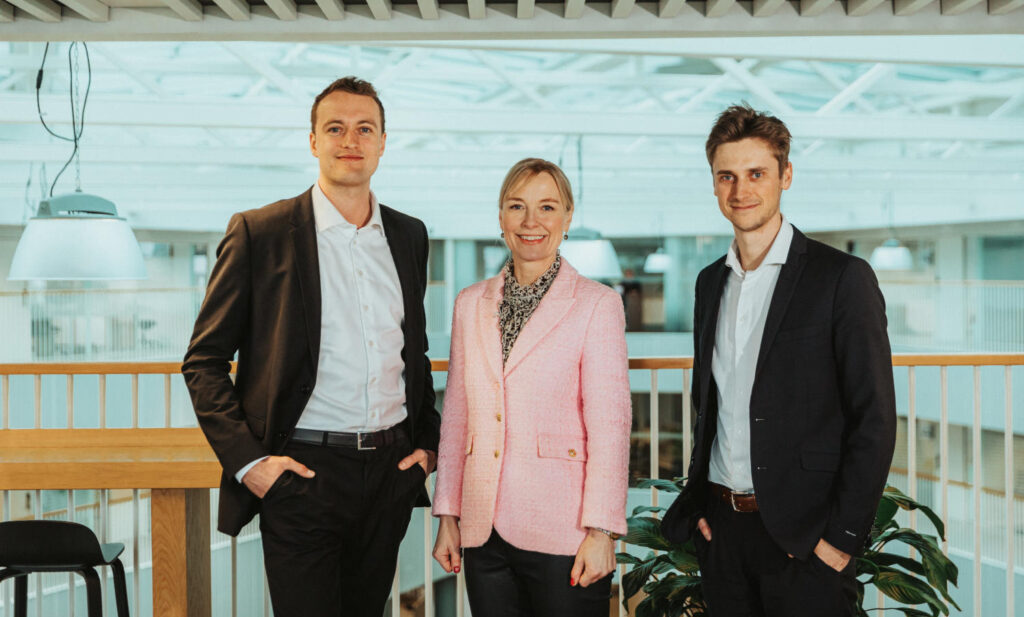XR technology already helps large companies inspect, maintain and repair machinery and buildings. But will technology in the future become indispensable across the value chain – or is it just nice to have?
Virsabi can thank the corona crisis for the fact that Augmented Reality glasses suddenly became a must have for Jorgensen Engineering, a Danish company that makes and sells packaging handling solutions for the food industry among others.

The company’s challenge was that once they had installed a new solution at a customer’s factory, the operators could rarely remember all the details from the training and therefore had to resort to heavy manuals.
“So we discussed how to use HoloLens (AR glasses produced by Microsoft, ed.) to support operators in their use of the solution,” says Jens Lauritsen, Chief Product Officer at Virsabi.
The project then came to a standstill, but when Industriens Fond funded research into the use of XR in the Danish industry, new life was breathed into the project. Then the corona crisis hit.
“It was an obvious choice to pull out the HoloLens glasses again so that Jorgensen Engineering’s customers could continue to receive support during the corona crisis. Jorgensen was limited by the fact that they could neither put a service employee on a plane nor send a local employee to the customer due to travel restrictions and local rules,” Lauritsen says.
Virsabi and Jorgensen Engineering, therefore, started testing so-called remote collaboration. The factory’s machine operator was introduced to the AR glasses, and the next time there was a problem with the packaging system, they could call a specialist at Jorgensen. The Jorgensen specialist is able to see the problem from the operator’s angle and share digital guidance and information, for example in the form of pictures and graphics directly on top of the packaging solution.
“We quickly realised that Jorgensen could help their customers reduce downtime on the machines, which is of great importance for production efficiency. They also didn’t have to put a specialist on a plane in order to fix the problem. So there was a case for remote collaboration after the pandemic as well,” Lauritsen says.

Today, Jorgensen Engineering has implemented XR solutions across the value chain – from product development and construction of the packaging handling solutions to sales and marketing.
In general, however, Lauritsen’s experience is that when Virsabi talked about AR technologies before the corona crisis, the reaction from potential customers was often that it was nice to have – not something indispensable. But with the hopefully imminent relief of the corona crisis, companies need to evaluate the pandemic’s teachings.
Lauritsen therefore points out that AR technologies can be used in the collaboration between supplier and customer, reduce the need for travel, make it possible to solve problems faster, and reduce companies’ carbon footprint – even when we can travel freely again.
Still, this does not necessarily mean that all companies will implement XR somewhere in the value chain.
“In my view, virtually all companies that can gain value from XR are in the process of testing it on their employees and customers. They see the value in it, and now they have to find out where it makes sense to implement the technologies in their particular customer relationships,” Lauritsen says.
VR is for special situations
Aarhus-native Cadpeople is, if anyone, a veteran of the XR industry.
The company was founded in 1992, when the founders were inspired by the sci-fi film The Lawnmower Man, a Frankenstein story about a gardener who, with the help of VR and a scientist, undergoes a major transformation.

“It’s full-blown VR with glasses and advanced technology. And that inspired us to start working with RealTime 3D,” says Claus Riekehr Møller, founder and CEO of Cadpeople.
He elaborates that while both RealTime 3D and VR are built around models in 3D, RealTime 3D is on a touch screen, while VR must be experienced through a pair of glasses.
Today, the company has found its niche in visual communication and digital learning, and Cadpeople has several heavy industrial companies as well as schools and educational institutions as customers. One of them is the wind turbine manufacturer Vestas, for which Cadpeople has completed several solutions – both in XR and as RealTime 3D.
“We have recreated specific wind turbines in 3D, which the technicians can interact with and practice on via a large touch screen. Among other things, they can take control of the wind turbine and make various measurements with a multimeter,” Møller says.
He explains that Vestas has several thousand employees who have to take courses in servicing wind turbines every year. Therefore, it is a strong business case for Vestas that the technicians do not have to be flown to Denmark and taught there in a random wind turbine. The relevant wind turbines have all been recreated digitally so that the technicians can be taught in the right one.
That the course is created in a 3D model, and not as a VR experience, for example, is a conscious choice on the part of Cadpeople.
“When a customer asks us to create a product for them, we begin to analyze what their real needs are as a digital learning consultancy. If the customer is teaching in a classroom, for example, it is not optimal to let a single student into a VR room where the teacher cannot see what is happening,” Møller says.
Often the solution is to put the content on a touch screen. The content can still be created in 3D so that the teacher and students can rotate and interact with it, but the difference is that the teacher can better explain and engage with the students.

One of Cadpeople’s customers is the Danish wind turbine manufacturer Vestas.
“VR has always fascinated people because you can recreate everything in a virtual world. Therefore, many think that it is the only solution for them. The downside, though, is that when you put the glasses on, you cut yourself off from the rest of the room. In the long run, I therefore believe more in AR, where you also put on a pair of glasses but without shielding yourself from the physical space,” Møller says.
However, there are a number of unique use cases for VR glasses. Møller highlights situations where there is a need to put the user into a very specific space or learning situation.
“It’s hard to know how you react when you stand on top of a wind turbine and look down. Are you too high up to think it’s any fun? It’s a little late to find out once you’ve got the job,” Møller says.
The machines digital twin
When AR Comply’s customers put on their AR glasses, they not only see the room they are in, they also see the room’s digital twin. Machines, systems, and the building itself are connected to a number of digital points, which employees can unfold and, for example, see manuals and comments on errors and omissions.
The solution is targeted the manufacturing industry and AR Comply’s major goal is to digitize inspections, maintenance procedures, and inspections of complex equipment, buildings, and machinery.
“You can create a digital twin of all processes around maintenance, inspection, and the documentation of critical data. So you see the factory or the machine in real life, but you also have this digital layer, which makes solving a task more efficient and time-saving,” says Anders Havelund Krøyer, CEO of AR Comply.

The concept behind AR Comply was originally developed by Kanda, who creates training material in XR. After a successful collaboration with a major shipping company in 2018, Kanda put the project on hold. The following year, however, Anders Havelund Krøyer was presented with the project and AR Comply was founded.
The company currently has one paying customer and several pilot projects running. Common to them is that AR Comply gets the customer on board early in the development process of their tailor-made software solution.
“Feedback is worth its weight in gold, because it enables us, at an early stage, to implement the feedback in the product development. Better to have that moment of clarity early in the process,” Krøyer says.
AR Comply often experiences challenges with the implementation of new technology in larger companies. Namely, that companies need stability, and that great security and predictability with old familiar procedures take precedence. Although innovation can potentially provide significant optimization, the implementation of new technology also always entails new risks. That balancing act can be a barrier.
Still, Krøyer believes that AR technology will come out on top.
“It is not a question of whether we will use the technology – but when. However, we need large companies that dare to take the first step, because they are also the companies that have the finances to test it. I have no doubt that the future will include some sort of AR layer with relevant data and guidance when it comes to optimizing these procedures,” Krøyer says.










 Kære læser, du er meget velkommen til at dele vores artikler på sociale medier, linke eller referere til artikler eller content på TechSavvy.media. Men ønsker du helt eller delvist at kopiere indhold fra sitet må det kun ske efter aftale med vores redaktion på editorial@techsavvy.media.
Kære læser, du er meget velkommen til at dele vores artikler på sociale medier, linke eller referere til artikler eller content på TechSavvy.media. Men ønsker du helt eller delvist at kopiere indhold fra sitet må det kun ske efter aftale med vores redaktion på editorial@techsavvy.media.
 Kære læser, du er meget velkommen til at dele vores artikler på sociale medier, linke eller referere til artikler eller content på TechSavvy.media. Men ønsker du helt eller delvist at kopiere indhold fra sitet må det kun ske efter aftale med vores redaktion på editorial@techsavvy.media.
Kære læser, du er meget velkommen til at dele vores artikler på sociale medier, linke eller referere til artikler eller content på TechSavvy.media. Men ønsker du helt eller delvist at kopiere indhold fra sitet må det kun ske efter aftale med vores redaktion på editorial@techsavvy.media.